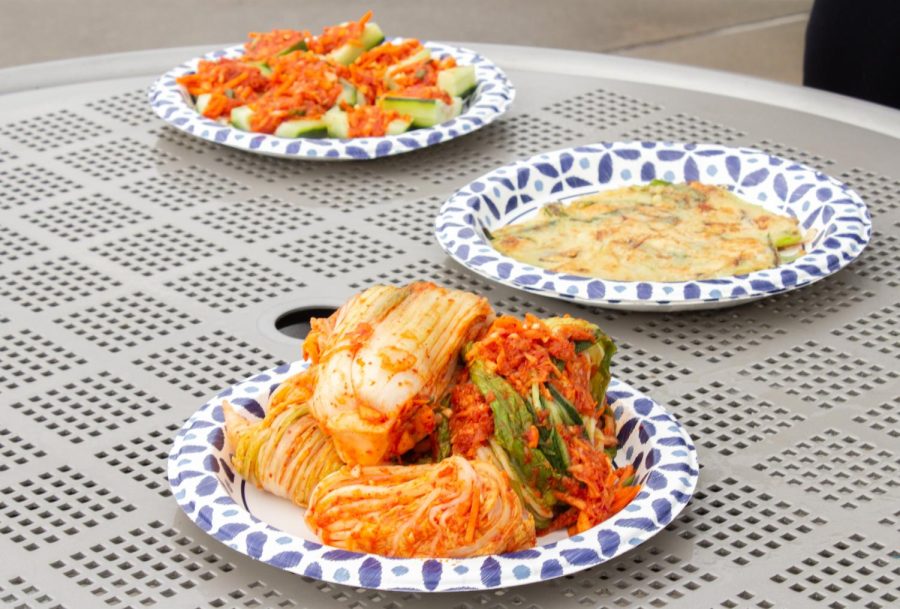Korean families get festive to make staple side dish
May 3, 2023
Kimchi, a traditional Korean “banchan,” or side dish, is – of all the various side dishes served with each meal – the most essential for all Korean people, regardless of the region they live in or which meal of the day it is they are eating. Kimchi, in my opinion, can best be described as a fermented vegetable or fruit that has been brined and mixed with some sort of seasoning.
The most recognized version of kimchi would be napa cabbage kimchi (baechu-kimchi or pogi-kimchi) with a salty and spicy red chili pepper seasoning. However, according to Na Kijoung, a Korean born and raised adviser at SIU, says the original napa cabbage kimchi recipes did not include anything spicy or overly sweet.
There is a recipe today called white napa cabbage kimchi (baek-baechu-kimchi). This kimchi, which involves fewer ingredients, and is fermented without any chili peppers, is perhaps the closest thing to the original recipe for kimchi from around 4,000 years ago. It was because of Portuguese traders coming to Japan and Korea from their South American colonies during the late 1500’s that Koreans began growing and cooking with various chili pepper preparations in their food and thus incorporating them into their diet on a wide scale. Na said before that time, kimchi wasn’t sweet or spicy.
Advertisement
There are many types of fruits and vegetables used to make kimchi, including napa cabbage, cubed Korean daikon radish, bok choy, cucumber or mustard greens. One regional specialty of Gangwon/Kangwon province puts a spicy kimchi paste inside the head of a salted raw squid and leaves it to ferment! The squid is first disinfected by scrubbing and brining with sea salt. The lactic acid and overall natural vinegars created by the kimchi paste results in it being “cooked” by timely submersion into the overall acidic environment.
It is worth noting that not only does each region within each province of the Korean peninsula have their own recipes for various types of kimchi; but each family within that particular culinary region has their own recipe, too. They subtly change based on seasonal produce availability and even what each family can afford to add into their family’s kimchi.
Na said, “depending on what you have as your main dish, I like to have a different kind of kimchi.”
The major variations in recipes of kimchi in Korea are limited to five. First, you have the most internationally famous variety which is in the style of South Korea’s capital, Seoul. Secondly, you have Mokpo style (named for the southwestern-most port city). Thirdly, you have Kaesong-style (the old capital of the Goguryeo Dynasty). Fourthly, you have Pyongyang style kimchi (named after the North Korean capital). Finally, you have Hamgyong province style Kimchi (found in the northeastern region), which tends to be less sweet than all of the other regional recipes, as well as the most heart healthy as it uses less salt.
The northern style of kimchi tends overall to be less sweet with little to no sugar being added and more mild with less hot pepper flakes being used. The largest difference between northern and southern regional recipes is that the Southern people use fish sauce (heavily salted fermented anchovy liquid) whereas the Northern people use fish paste (different types of neutral flavored fish or seafood that has been salt cured then pureed). The Southern Korean regions and their people also tend to use more ingredients that are viewed by other Korean communities around the world as optional or excessive.
Kimchi is largely made in the autumn season to have on hand for the winter and again in spring for summertime kimchi. Many families and/or neighborhoods have all the women, usually middle aged or older women from each household, get together and make kimchi at what they call “kimjang” time. This kimjang party or kimchi-making battle party, is more than just efficient with more laborers, but it is also a social event for all the wives and mothers in each family or in each neighborhood to get together, talk, visit, cook and just be social. Oftentimes, any children or young adults who get spotted walking by these women while they prepare for making kimchi, would be reined in and made to peel garlic cloves or wash vegetables for them. It is this aspect of kimchi-making parties that I find to be the most personable and humorous, because children trying to tiptoe around adults to avoid being put to work is commonplace among all cultures worldwide.
South Hamgyong Province (northeastern) style kimchi recipe:
Advertisement*
2 lbs- napa cabbage (washed and brined in salt water for 24 hours then rinsed and dried with paper towels),
0.5 lbs- mustard greens (roughly chopped into bite sized pieces) (optional),
1- large korean radish or large daikon radish (peeled and julienned),
5- green onions (chopped),
1 or 2- carrots (peels left on and julienned),
½- medium yellow onion (peeled and minced),
12- garlic cloves (peeled and minced),
1 tbsp- ginger root (peeled then minced or pureed),
¾- apple (peeled, cored and minced),
1- chestnut (peeled and minced),
4 tbsp- salted pollock filet (pureed) or dried pollock rehydrated w/ salted water (pureed),
¼ cup (give or take)- korean hot pepper flakes,
1 tsp- green plum syrup,
½ cup- mochiko porridge (boil ½ cup water and whisk in ½ tbsp sweet rice flour until thick),
pinch- salt,
Advertisement



